Lecture 31: Optimistic Linked Lists
COSC 273: Parallel and Distributed Computing
Spring 2023
Annoucements
- Leaderboard submission results tomorrow
- Next leaderboard submission is Friday? Monday?
- Take-home quiz: released Wednesday (Gradescope), due Friday
- concurrent linked lists
Today
Concurrent Linked Lists, Three Ways:
- Coarse locking
- Fine-grained locking
- Optimistic locking
A Generic Task
Store, access, & modify collection of distinct elements:
The Set ADT:
-
addan element- no effect if element already there
-
removean element- no effect if not present
- check if set
containsan element
Java SimpleSet Interface
public interface SimpleSet<T> {
// Add an element to the SimpleSet. Returns true if the element
// was not already in the set.
boolean add(T x);
// Remove an element from the SimpleSet. Returns true if the
// element was previously in the set.
boolean remove(T x);
// Test if a given element is contained in the set.
boolean contains(T x);
}
Linked List SimpleSets
- Each
Nodestores:- reference to the stored object
- reference to the next
Node - a numerical key associated with the object
- The list stores
- reference to
headnode - a
tailnode -
headandtailhave min and max key values - nodes have strictly increasing keys
- reference to
Why Keys?
Question. Why is it helpful to store keys in increasing order?
Our Goals
- Correctness, safety, liveness
- deadlock-freedom
- starvation-freedom?
- nonblocking??
- linearizability???
- Performance
- parallelism?
Synchronization Philosophies
- Coarse-Grained (
CoarseList.java)- lock whole data structure for every operation
- Fine-Grained (
FineList.java)- only lock what is needed to avoid disaster
- Optimistic (
OptimisticList.java)- don’t lock anything to read, only lock to modify
- Lazy (
LazyList.java)- use “logical” removal, only lock occasionally
- Nonblocking (
NonblockingList.java)- use atomics, not locks!
Coarse-grained Locking
One lock for whole data structure
For any operation:
- Lock entire list
- Perform operation
- Unlock list
See CoarseList.java
Coarse-grained Insertion
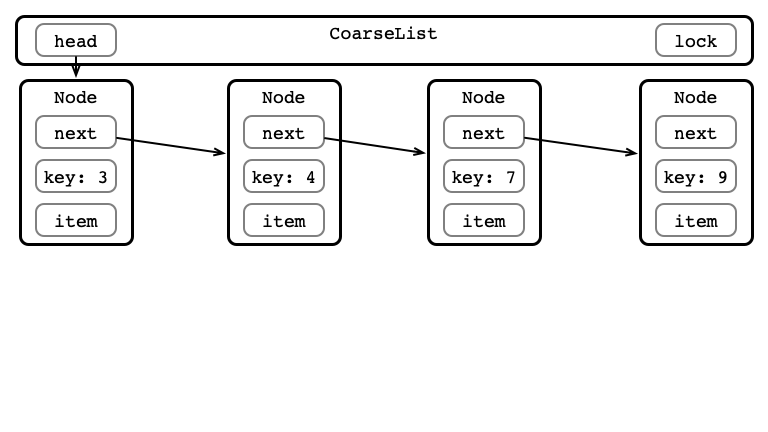
Step 1: Acquire Lock
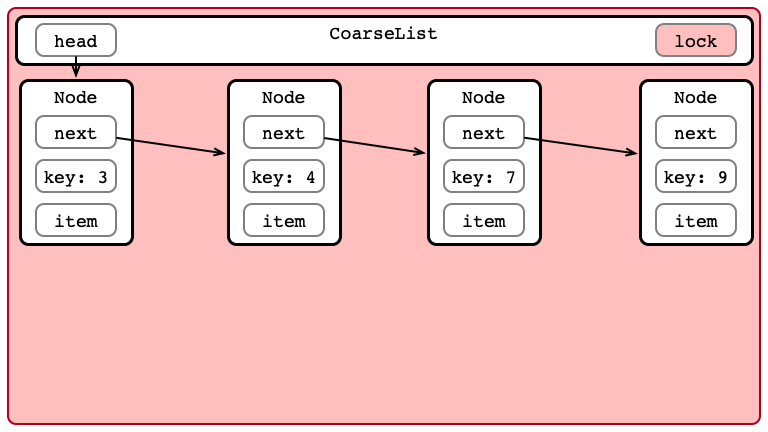
Step 2: Iterate to Find Location
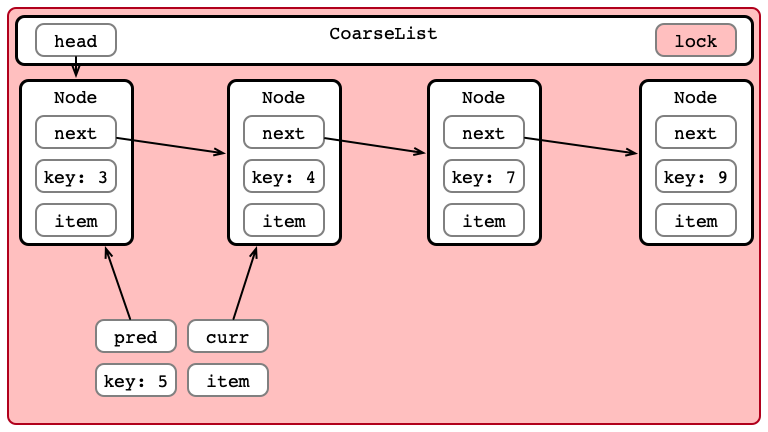
Step 2: Iterate to Find Location
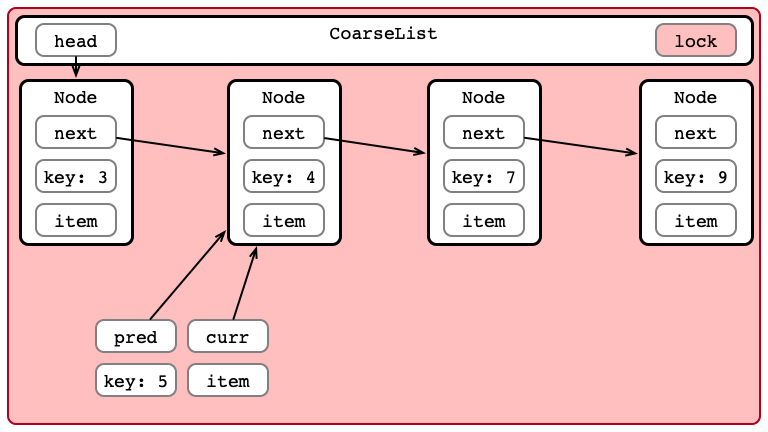
Step 2: Iterate to Find Location
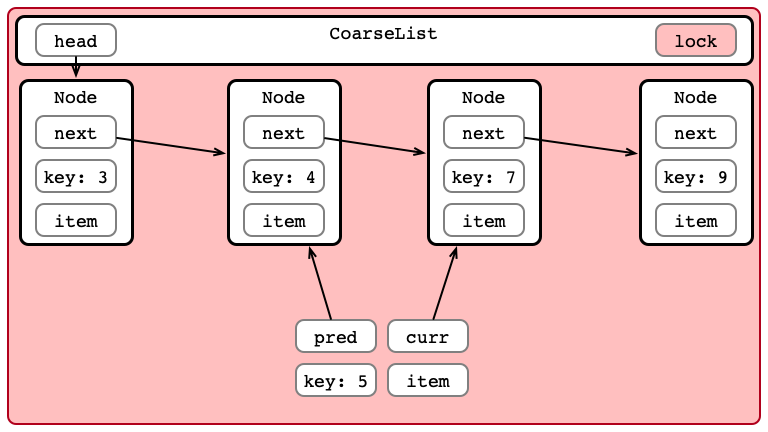
Step 3: Insert Item
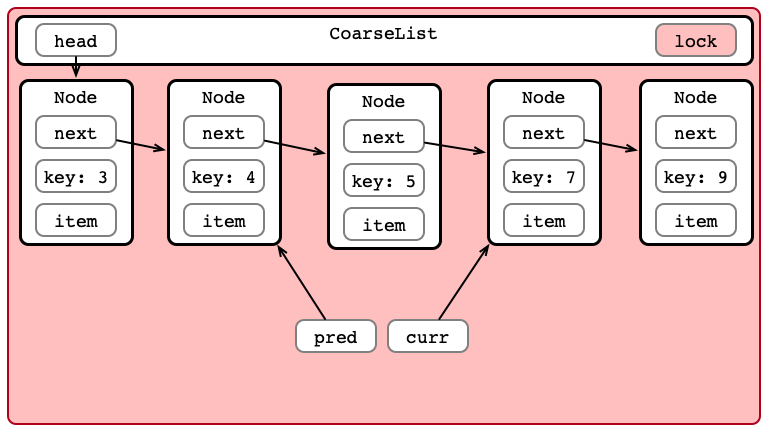
Step 4: Unlock List
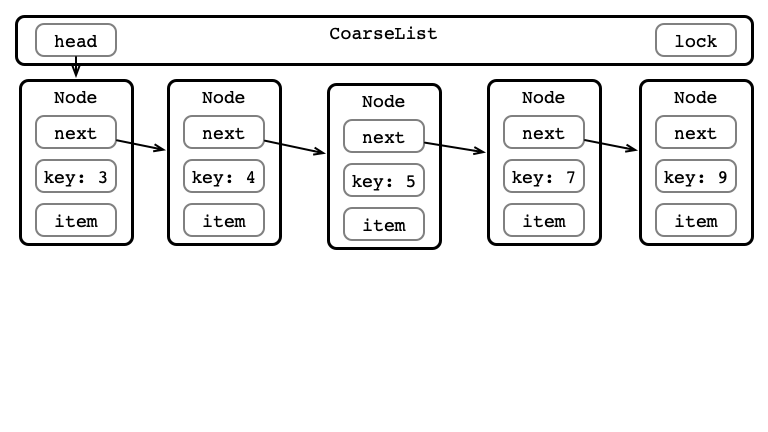
Coarse-grained Appraisal
Advantages:
- Easy to reason about
- Easy to implement
Disadvantages:
- No parallelism
- All operations are blocking
Fine-grained Locking
One lock per node
For any operation:
- Lock head and its next
- Hand-over-hand locking while searching
- always hold at least one lock
- Perform operation
- Release locks
See FineList.java
A Fine-grained Insertion
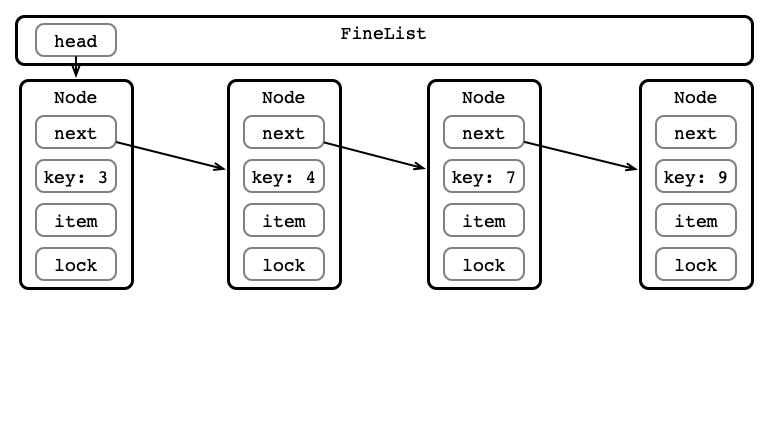
Step 1: Lock Initial Nodes
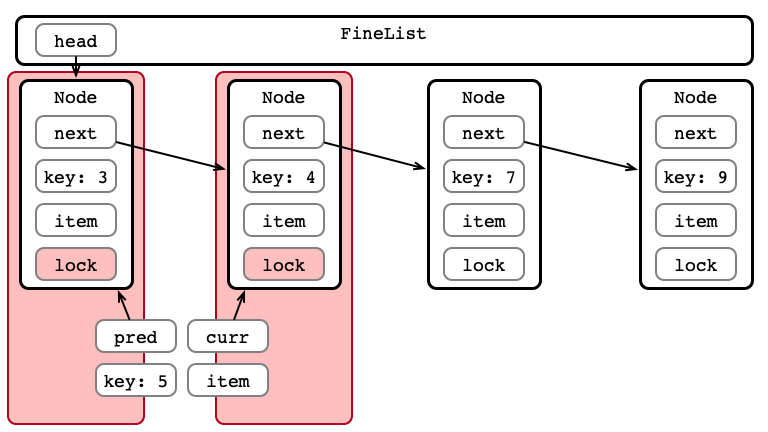
Step 2: Hand-over-hand Locking

Step 2: Hand-over-hand Locking
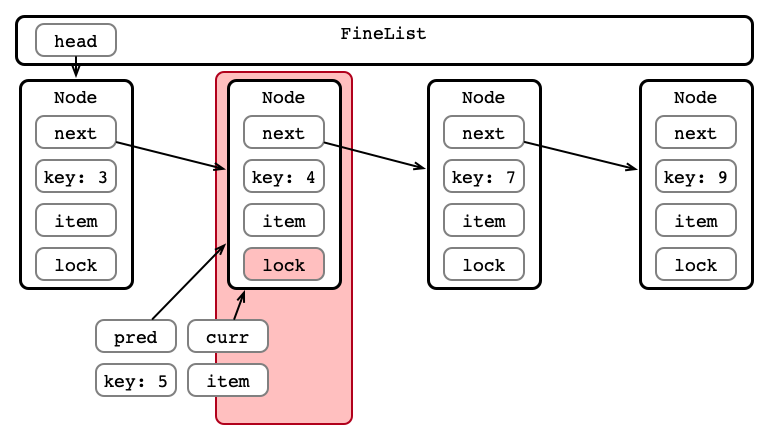
Step 2: Hand-over-hand Locking
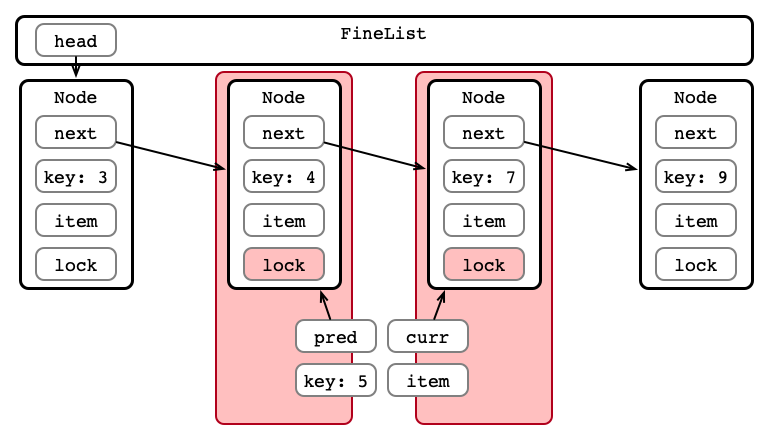
Step 3: Perform Insertion
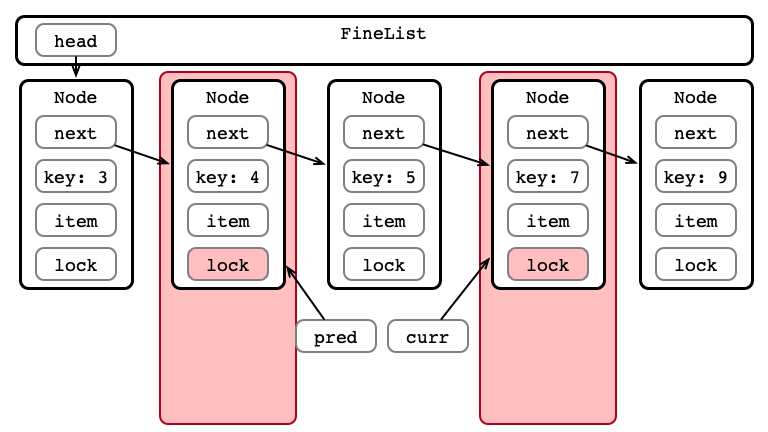
Step 4: Unlock Nodes
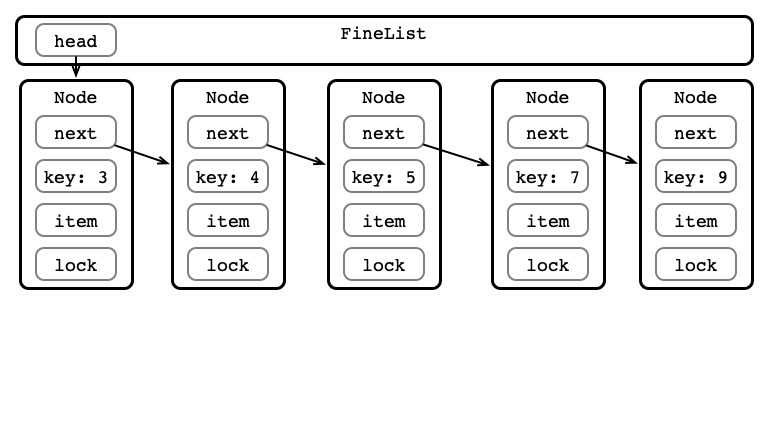
An Advantage: Parallel Access
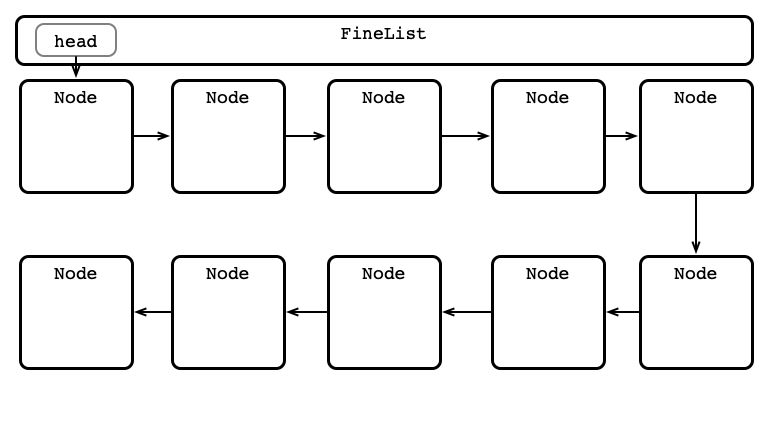
An Advantage: Parallel Access
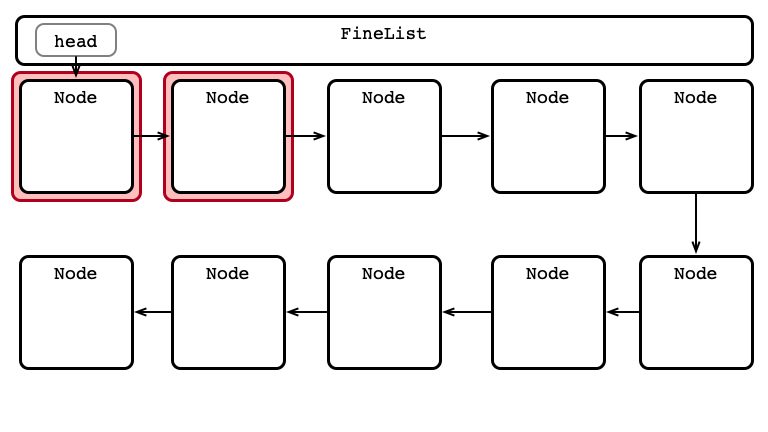
An Advantage: Parallel Access
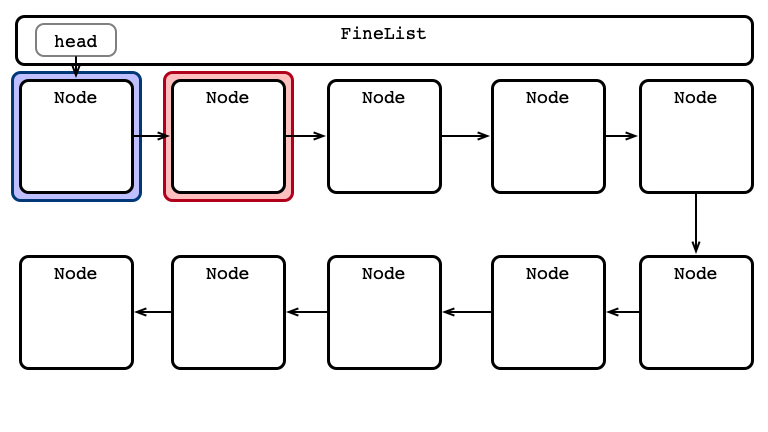
An Advantage: Parallel Access
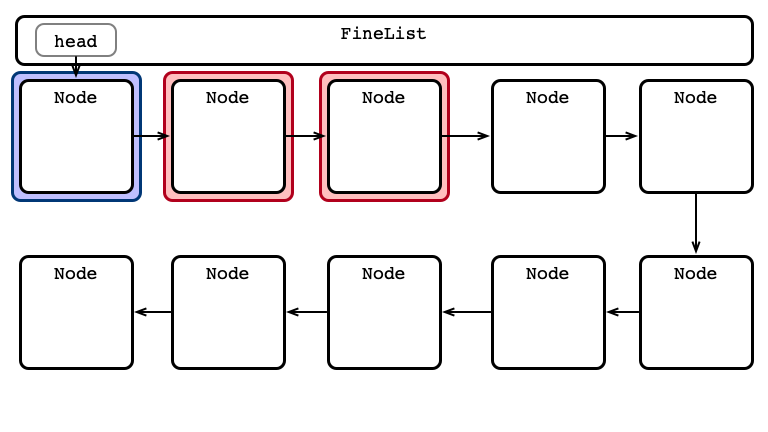
An Advantage: Parallel Access
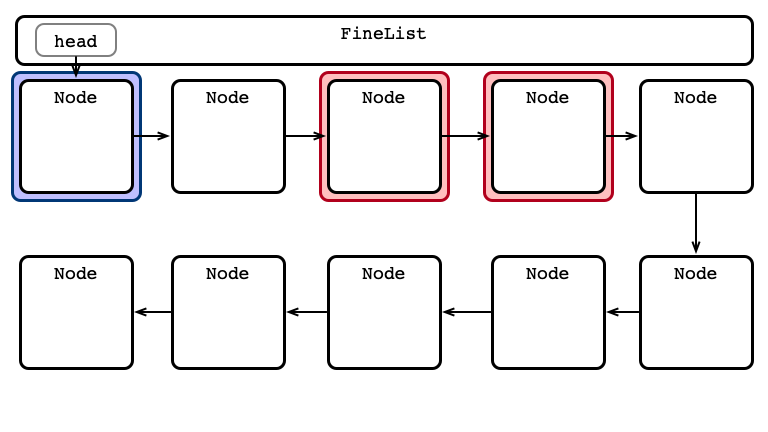
An Advantage: Parallel Access
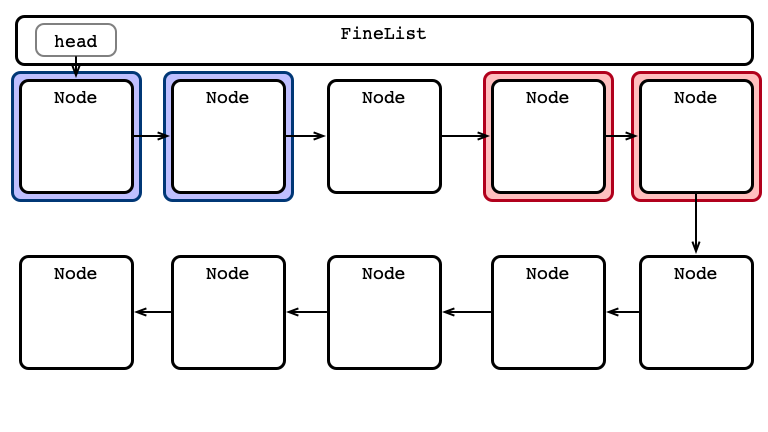
An Advantage: Parallel Access
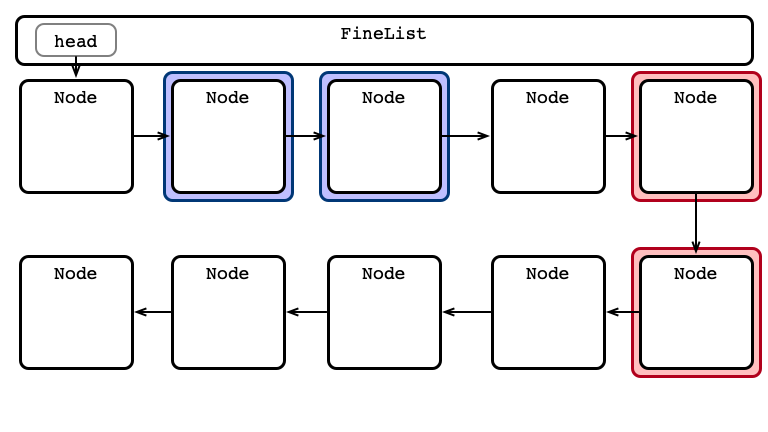
An Advantage: Parallel Access
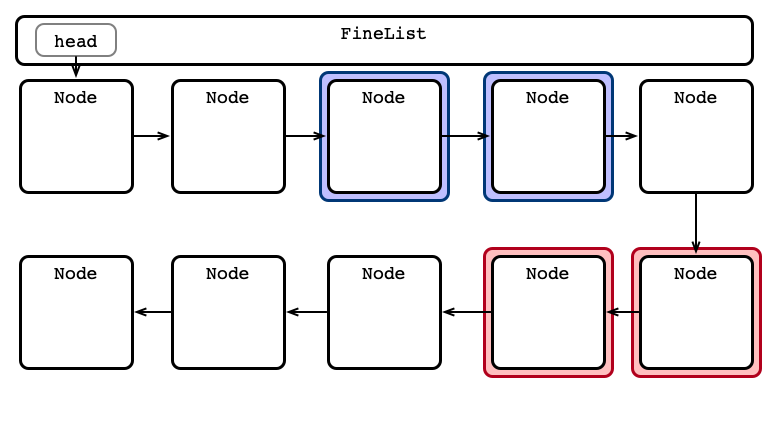
An Advantage: Parallel Access
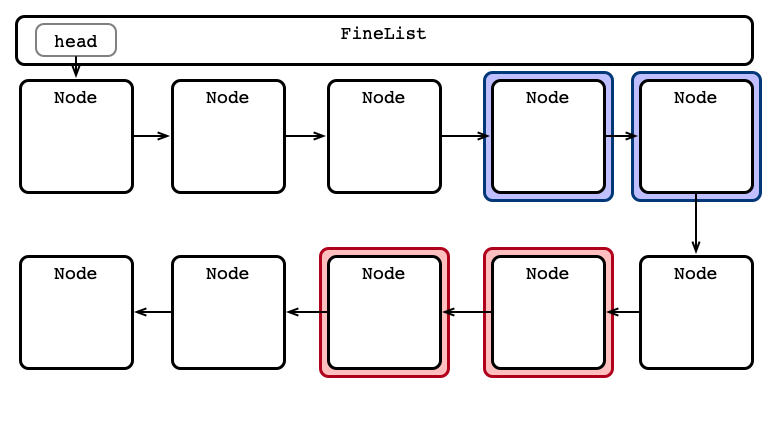
An Advantage: Parallel Access
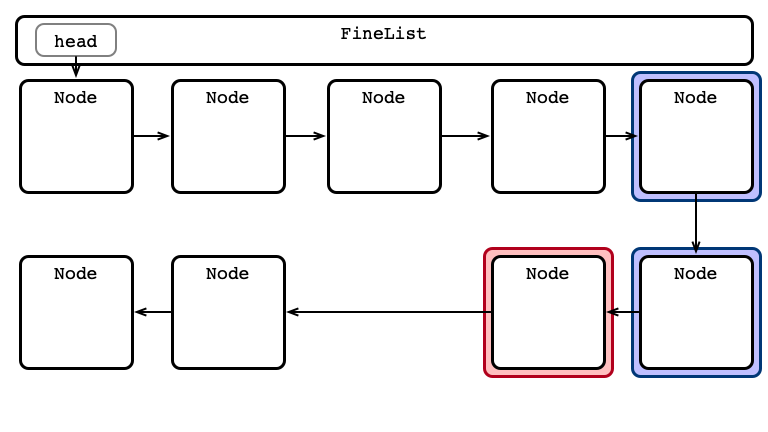
An Advantage: Parallel Access
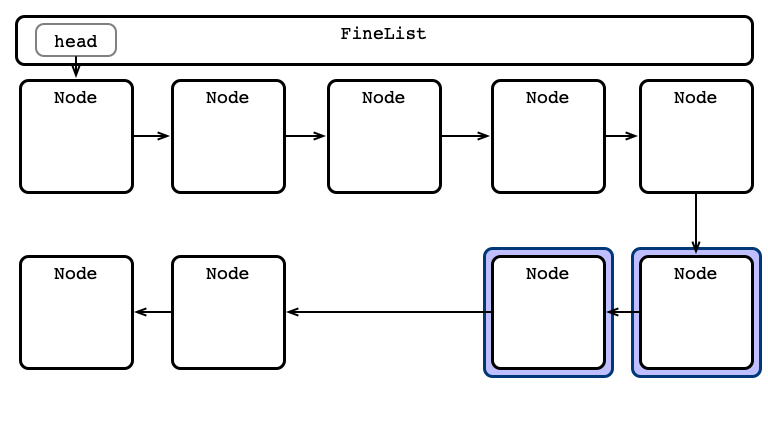
An Advantage: Parallel Access
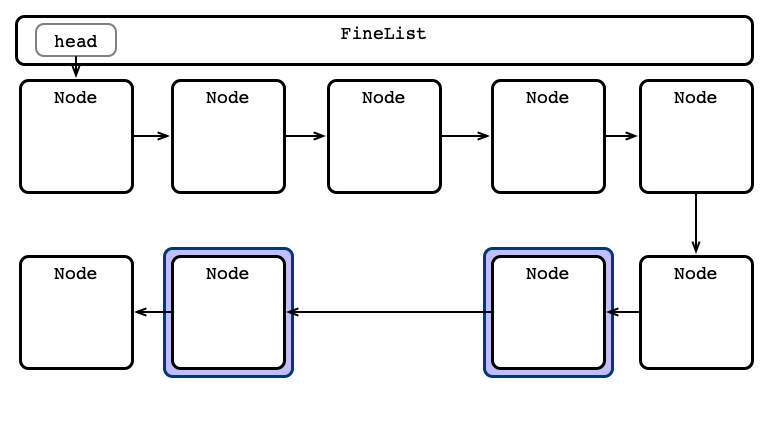
Fine-grained Appraisal
Advantages:
- Parallel access
- Reasonably simple implementation
Disadvantages:
- More locking overhead
- can be much slower than coarse-grained
- All operations are blocking
Optimistic Synchronization
Fine-grained wastes resources locking
- Nodes are locked when traversed
- Locked even if not modified!
A better procedure?
- Traverse without locking
- Lock relevant nodes
- Perform operation
- Unlock nodes
A Better Way?
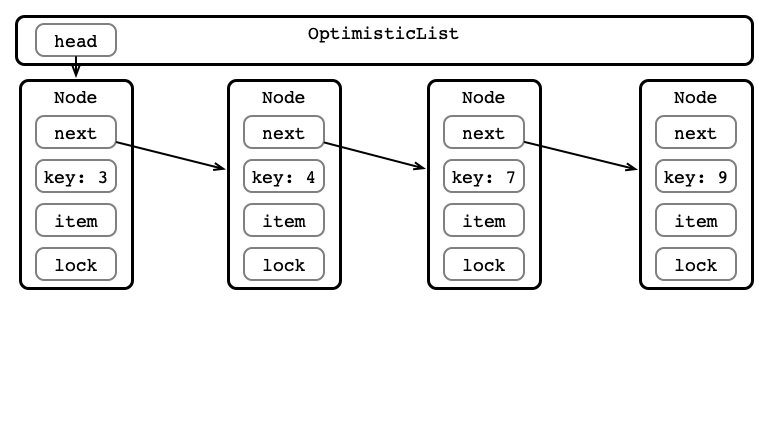
A Better Way?
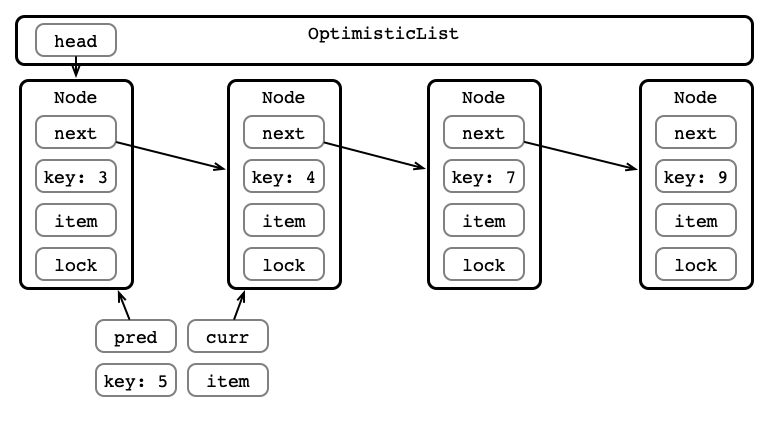
A Better Way?
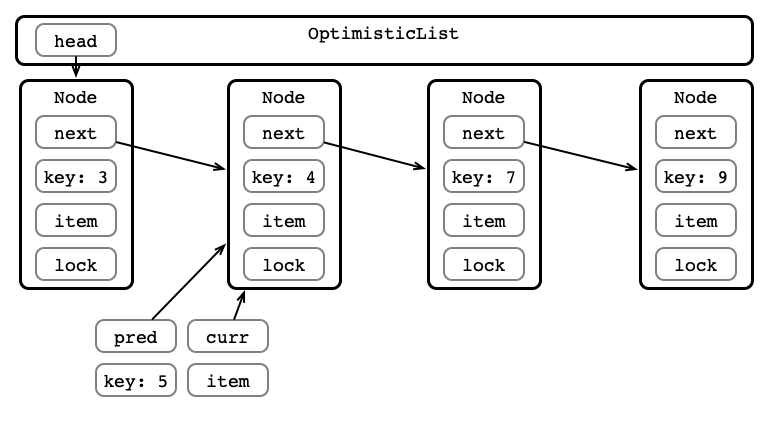
A Better Way?
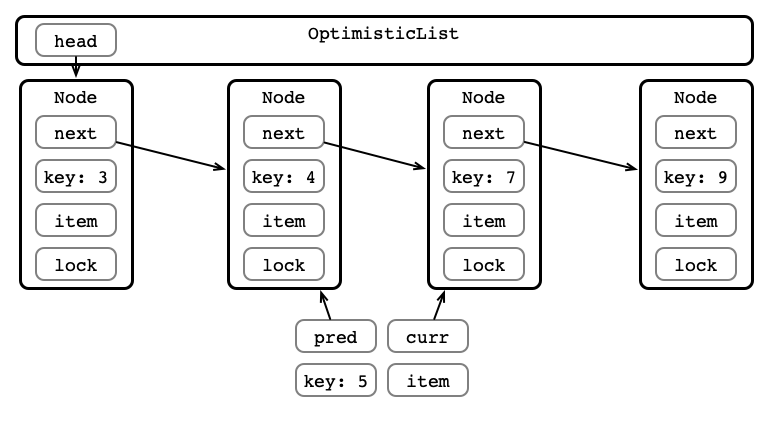
A Better Way?
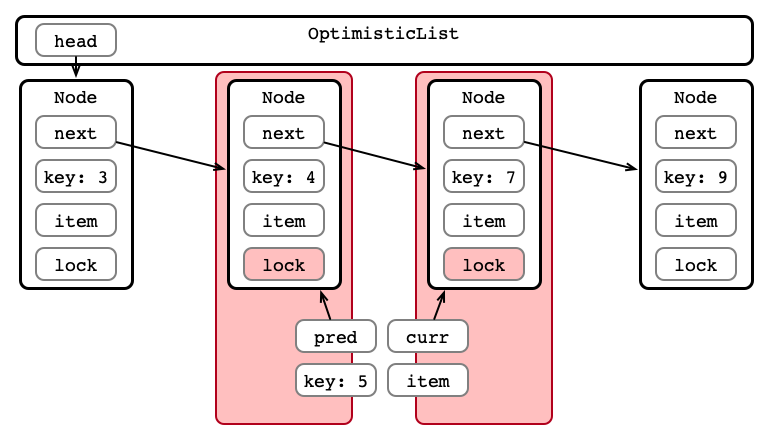
A Better Way?
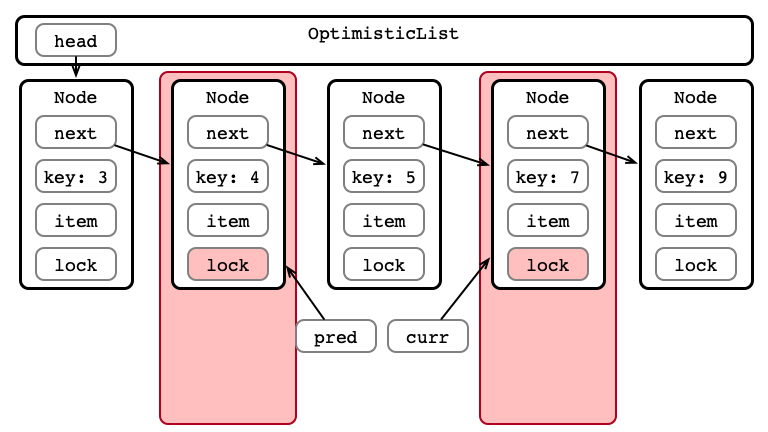
What Could Go Wrong?
An Issue!
Between traversing and locking
- Another thread modifies the list
- Now locked nodes aren’t the right nodes!
An Issue, Illustrated

An Issue, Illustrated
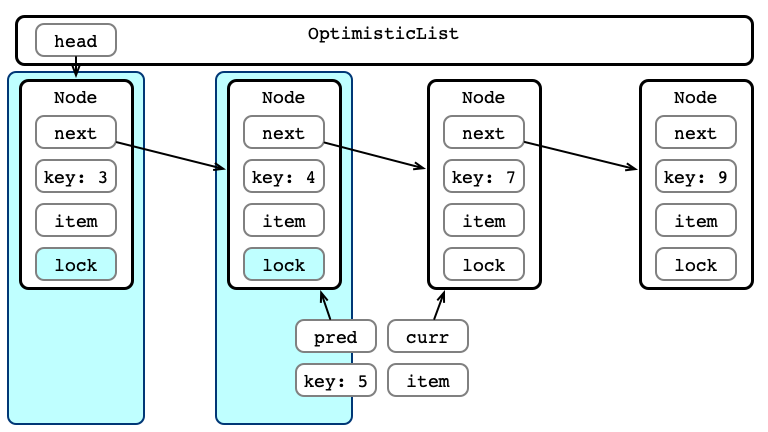
An Issue, Illustrated
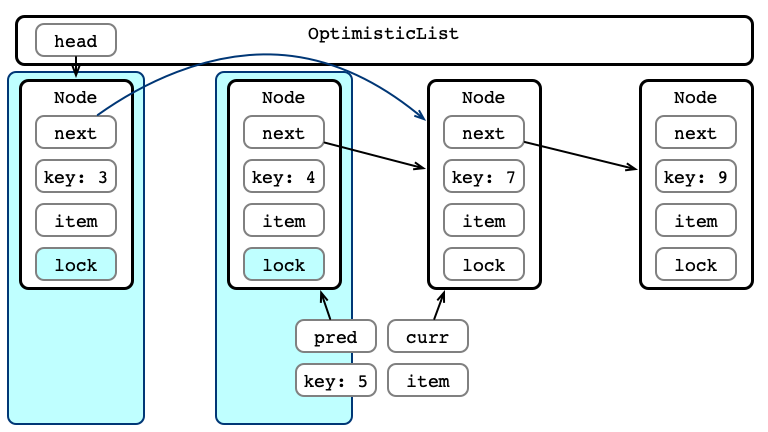
An Issue, Illustrated
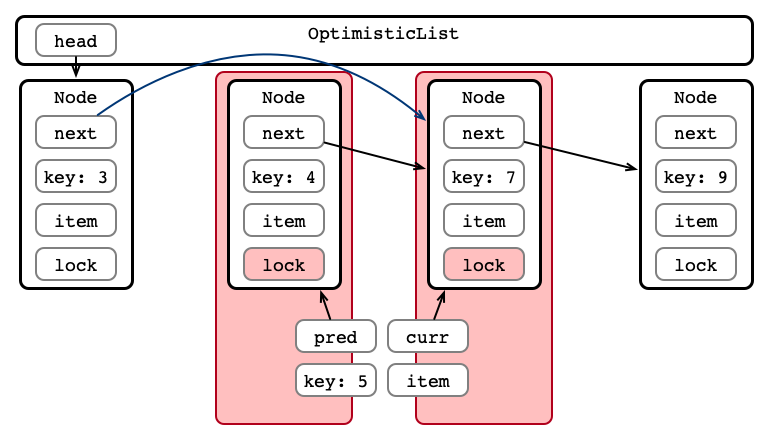
An Issue, Illustrated
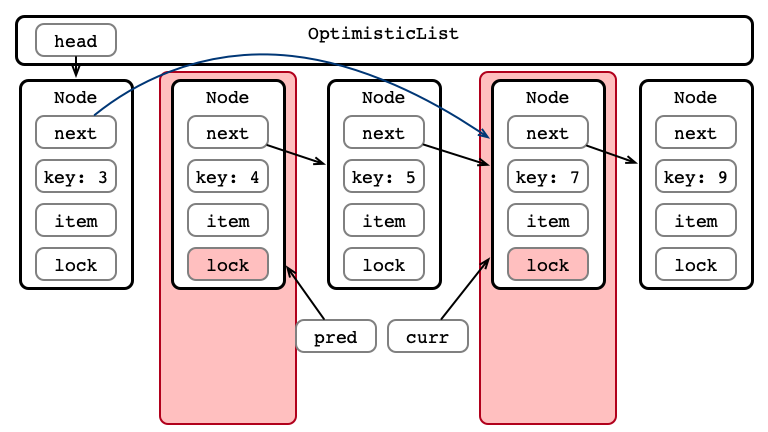
An Issue, Illustrated
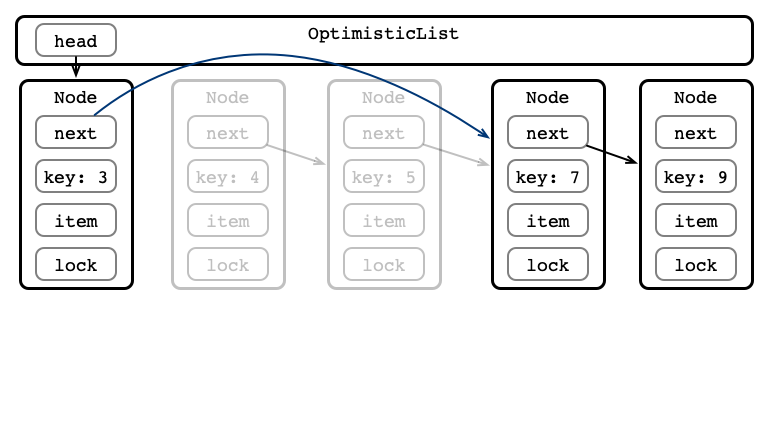
How can we Address this Issue?
Optimistic Synchronization, Validated
- Traverse without locking
- Lock relevant nodes
-
Validate list
- if validation fails, go back to Step 1
- Perform operation
- Unlock nodes
Seet OptimisticList.java
How do we Validate?
After locking, ensure that:
-
predis reachable fromhead -
currispred’s successor
If these conditions aren’t met:
- Start over!
Optimistic Insertion

Step 1: Traverse the List

Step 1: Traverse the List

Step 1: Traverse the List

Step 2: Acquire Locks

Step 3: Validate List - Traverse
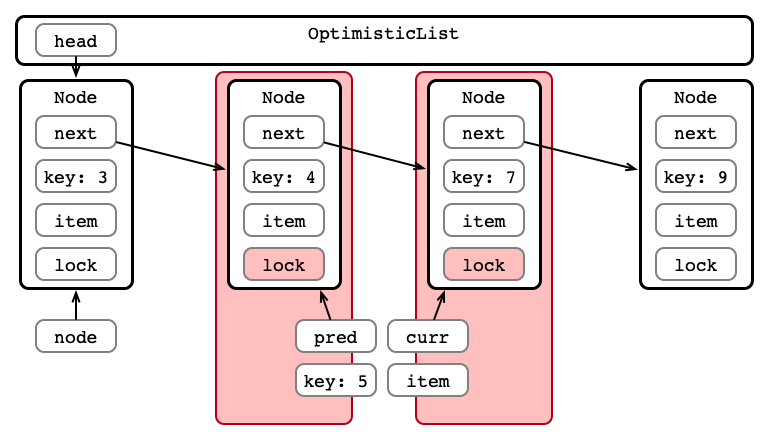
Step 3: Validate List - pred Reachable?
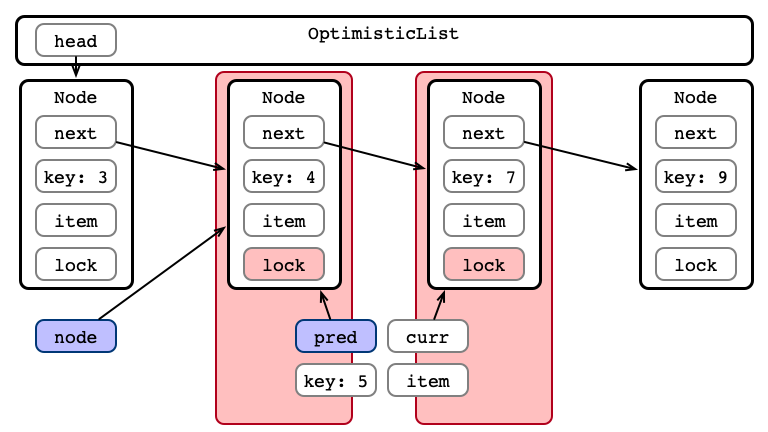
Step 3: Validate List - Is curr next?
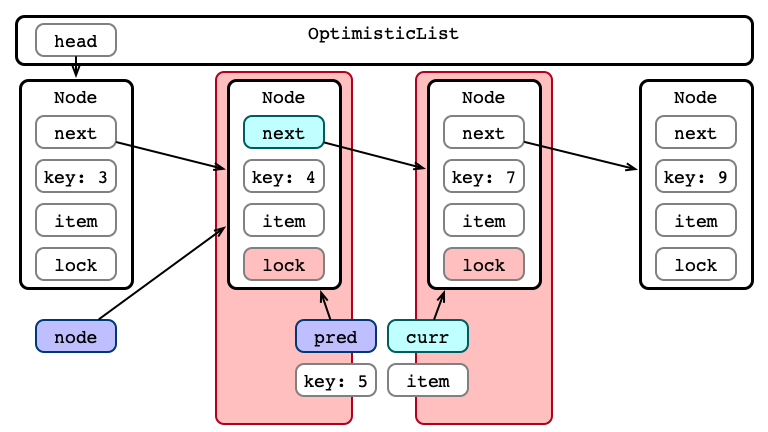
Step 4: Perform Insertion

Step 5: Release Locks
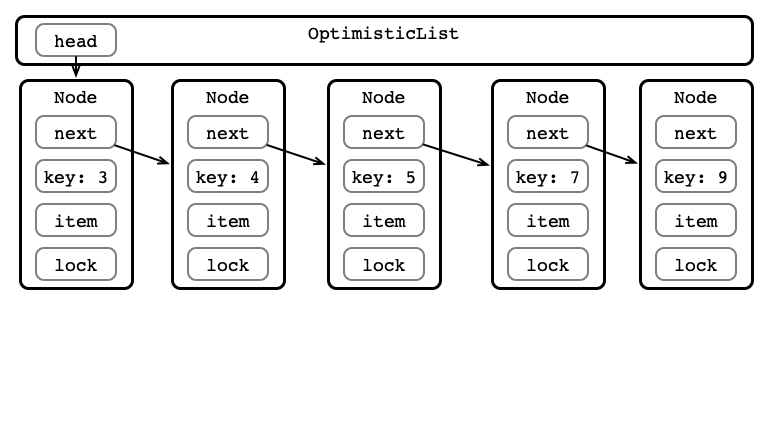
Implementing Validation
private boolean validate (Node pred, Node curr) {
Node node = head;
while (node.key <= pred.key) {
if (node == pred) {
return pred.next == curr;
}
node = node.next;
}
return false;
}
Optimistic Appraisal
Advantages:
- Less locking than fine-grained
- More opportunities for parallelism than coarse-grained
Disadvantages:
- Validation could fail
- Not starvation-free
- even if locks are starvation-free
Performance Tests
On HPC Cluster:
- Compare running times of performing 1M operations
-
add/remove/containssequence chosen at random - elements chosen from
1toNat random-
Nis universe size
-
-
- Parameters
- universe size $\approx$ set size
- number of threads
See SetTester.java
Performance Predictions?
Under what conditions do you expect coarse/fine/optimistic strategies to be performant?
- Number of threads (1 to 128 on HPC)
- Set universe size (8 to 8,192)
Performance v. Size, 1 Thread
Performance v. Size, 128 Threads
Time v. Threads, 8 Elements
Time v. Threads, 8,192 Elements
Coarse Time v. Threads
Fine Time v. Threads
Optimistic Time v. Threads
Next Time
Another Way: Lazy Synchronization
- don’t modify the list unless you really have to






